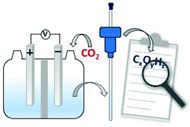Publication
900
Dalton Trans., 49, 4257-4265, 2020
DOI:10.1039/c9dt04749b
|
|
|
|
|
|

|
Manifesto for the routine use of NMR for the liquid product analysis of aqueous CO2 reduction: from comprehensive chemical shift data to formaldehyde quantification in water
|
|
|
|
Kamal Chatterjee, Etienne Boutin, and Marc Robert
Université de Paris, Laboratoire d'Electrochimie Moléculaire, CNRS, F-75013 Paris, France
Abstract
CO2 reduction research is at a critical turnaround since it has the potential to partially or even substantially fulfil future clean energy needs. CO2-to-CO electrochemical conversion is getting closer from industrial implementation requirements. Efforts are now more and more directed to obtain highly reduced products such as methanol, methane, ethylene, ethanol, etc., most of them being liquids. Gas-phase products (e.g., CO, CH4) are typically detected and quantified by well-defined gas chromatography (GC and GC/MS) protocols. On the other hand, NMR, GC-MS, HPLC have been used for the liquid phase characterization, but no routine technique has yet been established, mainly due to lack of versatility of a single technique. Additionally, except NMR and GC-MS, classical techniques cannot distinguish 13C from 12C products, although it is a mandatory step to assess products origin. Herein, we show the efficiency and applicability of 1H NMR as routine technique for liquid phase products analysis and we address two previous shortcomings. We first established a comprehensive 1H and 13C NMR chemical shifts list for all 12CO2 and 13CO2 reduction products in water ranging from C1 to C3. Then we overcame the difficulty of identifying aqueous formaldehyde intermediate by 1H NMR through an efficient chemical trapping step, along with isotopic signature study. Formaldehyde can be reliably quantified in water with a concentration as low as 50 μM. |

